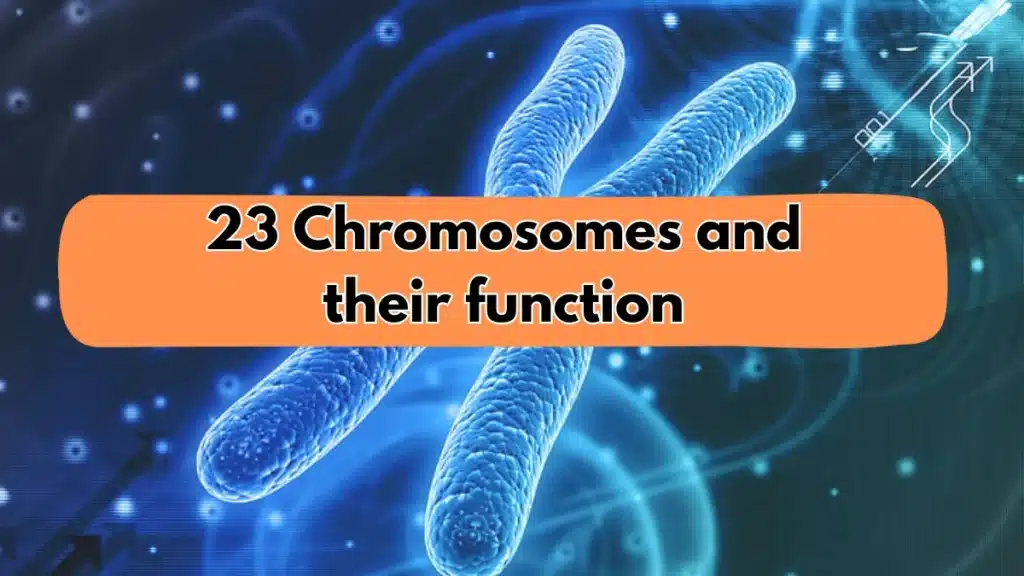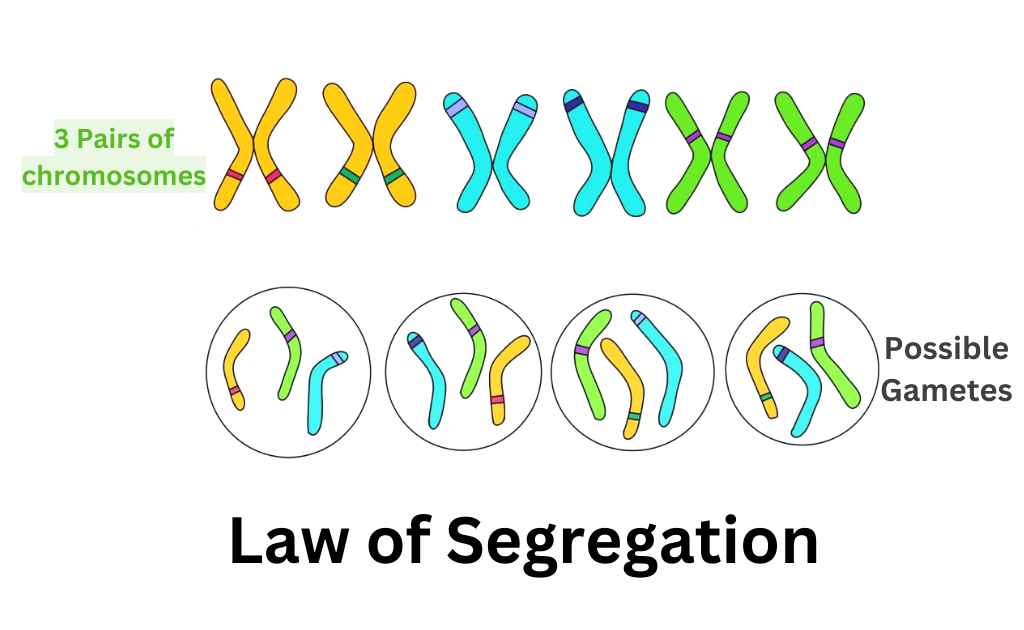23 Chromosomes and Their Functions
October 29, 2024
Chromosomes play an essential role for passing on genetic information from one generation to the next. Most chromosomes, which serve as the permanent genetic material in eukaryotes, are composed of DNA.

Each human chromosome contains numerous genes that code for different proteins, playing a key role in shaping the organism’s traits. Recent research has allowed scientists to explore and understand the functions of all 23 human chromosomes.
The table below highlights the human genes linked to each of 23 chromosomes and their function.
| No of Chromosome | Gene present | Function | Disease |
| 1 | GBA (Glucocerebrosidase) PS2 (Persenilin 2) HPC1 (Hereditary Prostate Cancer 1) | – Breaks down fatty substances in cells – process proteins like amyloid precursor protein (APP) – maintains cellular differentiation and normal structure of epithelial tissues | – Gaucher Disease, -Alzheimer’s disease -Prostate Cancer |
| 2 | ETM2 (Ewing Tumor MicroRNA 2) MSH2 (MutS Homolog2) PAX3 (Paired Box Gene 3) | – regulate gene expression in tumors – DNA mismatch repair during cell division. – Regulates early development of muscles and nervous system | -Essential tumor -Colon cancer – Waardenburg Syndrome |
| 3 | MLH1 (MutL Homolog1) VHL (Von Hippel-Lindau) | – DNA mismatch repair; maintains genetic stability. – Regulates cell growth, oxygen sensing. | – colorectal cancer – Von Hippel-Lindau Disease |
| 4 | EVC (Ellis-van Creveld) HD (Huntington) FGFR3 (Fibroblast Growth Factor Receptor 3) | – Affects cartilage and bone growth. – Impacts brain function – Regulates bone growth | -Ellis van creveld syndrome – Huntington disease – Achondroplasia |
| 5 | CKN1 (Cockayne Syndrome 1) SMN1 (Survival Motor Neuron 1) DTD (Diastrophic Dysplasia) | – DNA repair; affects cell aging. – Essential for motor neuron function – Affects cartilage and bone development. | -Cockayne syndrome -Spinal Muscular Atrophy -Diastrophic dysplasia |
| 6 | SCA1 (Spinocerebellar Ataxia Type 1) HFE (Hemochromatosis Gene) IDDM1 (Insulin-Dependent Diabetes Mellitus Type 1) | – Affects coordination and balance – Regulates iron absorption – Affects insulin production | -Spinocerebellar ataxia -Hemochromatosis –Diabetes |
| 7 | GCK (Glucokinase) ELN (Elastin) CFTR (Cystic Fibrosis Transmembrane conductance Regulator) | – Regulates glucose levels in blood. – Provides elasticity to connective tissues. – Regulates chloride ion transport. | – Diabetes – Williams Syndrome – Cystic Fibrosis |
| 8 | WRN (Werner Syndrome Helicase) MYC (Myelocytomatosis Oncogene) | -DNA repair and genomic stability. – Transcription factor that regulates cell growth, and apoptosis. | -Warner syndrome -Burkitt lymphoma |
| 9 | TSC1 (Tuberous Sclerosis Complex 1) FRDA (Friedreich’s Ataxia) ABCI (ATP-Binding Cassette, Sub-Family) | – Helps control cell growth. – Mitochondrial function and iron management. -Helps move molecules in and out of cells. | -Tuber Sclerosis -Friedrich’s ataxia -Tangier disease |
| 10 | GAT (Gyrate Atrophy) PAHX (Peroxisomal Alanine Glyoxylate Aminotransferase) | – Metabolizes arginine – Metabolizes glyoxylate in peroxisomes | – Gyrate Atrophy of the Choroid and Retina – Refsum disease |
| 11 | LQT (Long QT) ATM (Ataxia telangiectasia) MEN1 (Multiple endocrine neoplasia 1) | – Regulates heart rhythm – DNA repair and cell cycle regulation – Tumor suppressor, regulates cell growth | -Sudden cardiac arrest – Neurodegenerative disorder, immunodeficiency – tumors in endocrine glands |
| 12 | PXR1 (Peroxisomal Biogenesis Factor 1) PAH (Phenylalanine Hydroxylase) | – Formation of peroxisomes – Converts phenylalanine to tyrosine in the liver | -Zellweger syndrome -Phenylketonuria |
| 13 | BRCA2 (Breast cancer gene 2) ATP7B (ATPase Copper Transporting Beta) RBA1 (Retinoblastoma 1) | -Repairs DNA damage, maintain genomic stability -Regulates copper levels in the liver -Controls cell cycle progression, acts as a tumor suppressor | – Breast, thyroid and ovarian cancer. -Wilson disease – Retinoblastoma |
| 14 | PS1 (Persenilin 1) SERPINA1 (Serpin family A member 1) | -processing of amyloid precursor protein -Inhibits proteases and protects tissues from damage | -Alzheimer’s Disease (Type 3) – Alpha 1 Antitrypsin Deficiency |
| 15 | FBN1 (Fibrillin-1) HEXA (Hexosaminidase A) | -Provides structural support in connective tissues -Breaks down GM2 gangliosides in nerve cells | -Marfan Syndrome – Tay Sachs Disease |
| 16 | HBA 1 (Hemoglobin subunit Alpha 1) PKD1 (Polycystin 1) | -Produces alpha-globin chains, essential for hemoglobin –kidney tubule development and cell signaling | -Alpha thalassemia -Polycystic kidney disease |
| 17 | BRCA 1 (Breast cancer gene 1) CMT1A (Charcot-Marie Tooth A1) | – DNA repair, maintain genomic stability -Myelin sheath formation in peripheral nerves | -Breast and ovarian cancer. -Charcot Marie Tooth disease type 1A |
| 18 | DPC4 (Deleted in Pancreatic Cancer 4) NPCI (Niemann-Pick C1) | -Tumor suppressor gene; involved in TGF -Regulates cholesterol | -Pancreatic cancer -Niemann pick disease |
| 19 | APOE (Apolipoprotien E) DMPK (Dystrophia Myotonica Protein Kinase) | -Lipid transport, neuron repair -Regulates muscle contraction and electrical activity | -Atherosclerosis -Myotonic Dystrophy Type 1 |
| 20 | ADA (Adenosine Deaminase) | -Breaks down toxic deoxyadenosine, vital for immune cells | -Severe Combined Immunodeficiency (SCID) |
| 21 | SOD1 (Superoxide Dimutase 1) APS1 (Autoimmune Polyendocrine Syndrome 1) | -Neutralizes harmful superoxide radicals -Regulates immune tolerance | -Amyotrophic Lateral Sclerosis (ALS) -Autoimmune Polyendocrine Syndrome Type 1 |
| 22 | DGS (DiGeorge Syndrome gene) BCR (Breakpoint Cluster Region gene) | -Development of heart, thymus and other organs -Cell signaling and regulation | -DiGeorge Syndrome -Chronic Myeloid Leukemia |
| Chromosome X | DMD (Dystrophin) ATP7A (ATPase Copper Transporting Alpha) ALD (Adrenoleukodystrophy) | – Provides muscle fiber stability – Regulates copper levels in the body – Breaks down very long-chain fatty acids | – Duchenne Muscular Dystrophy (DMD) – Menkes Disease -X linked Adrenoleukodystrophy |
| Chromosome Y | SRY (Sex-determining Region Y) | -Develpoment of male characteristics | -Swyer Syndrome (46 XY gonadal dysgenesis) |
File Under:







Leave a Reply